Managerial Economics: China's Economic System and Globalization
VerifiedAdded on 2022/09/07
|16
|4454
|27
Report
AI Summary
This report provides a comprehensive analysis of China's global economic impact, examining its economic system, which is characterized as a mixed economy. It explores the roles of privatization and globalization in China's remarkable economic growth, discussing the historical context and various routes of privatization, including management employee buy-outs and sales to outsiders. The report delves into the arguments for and against privatization, the reasons behind China's privatization policies, and the nature and causes of business globalization. It also outlines the stages involved in the economic transition of globalization. Furthermore, the report addresses the environmental issues stemming from China's economic development and discusses the country's natural resources and conservation efforts, offering a well-rounded view of China's economic landscape and its implications.
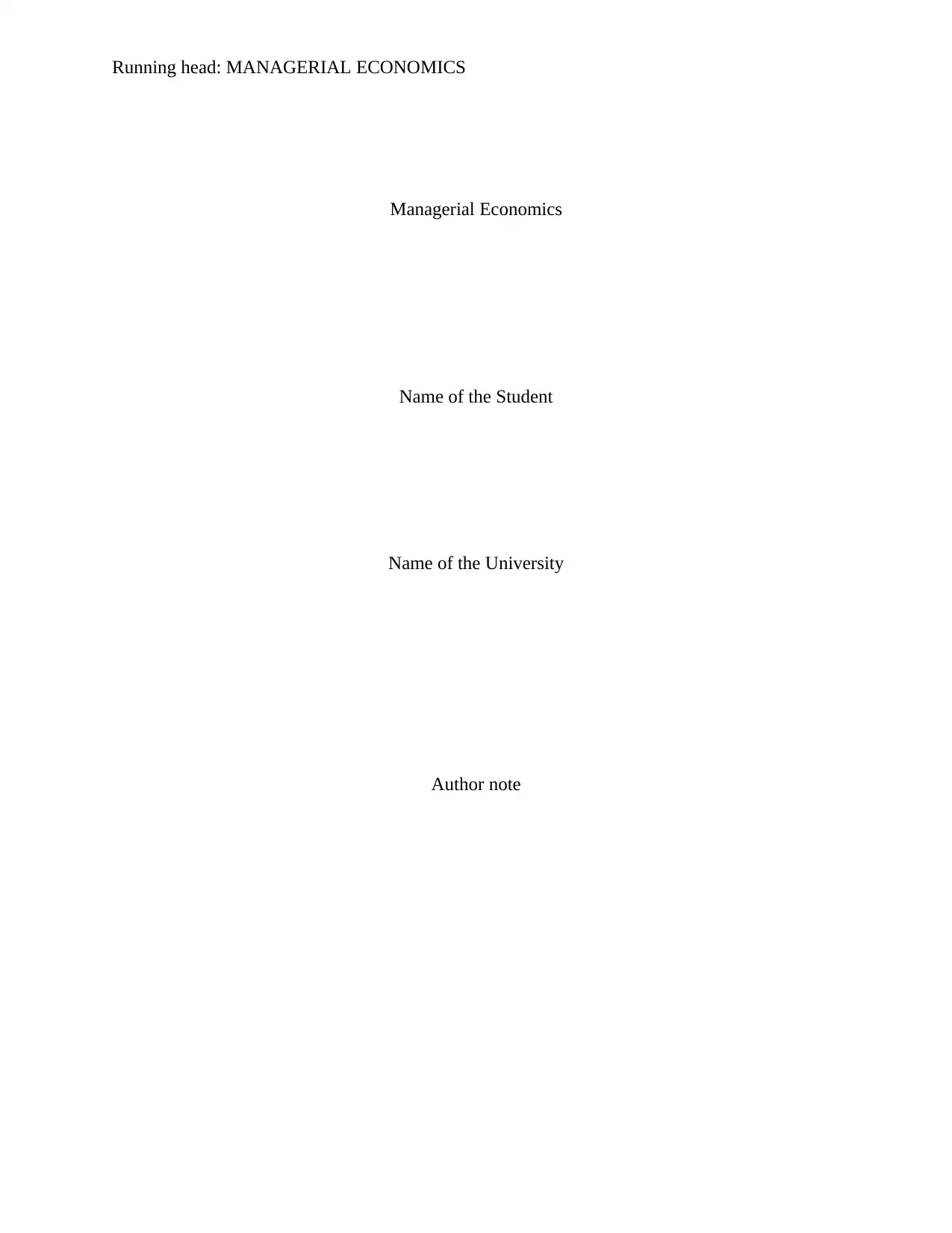
Running head: MANAGERIAL ECONOMICS
Managerial Economics
Name of the Student
Name of the University
Author note
Managerial Economics
Name of the Student
Name of the University
Author note
Paraphrase This Document
Need a fresh take? Get an instant paraphrase of this document with our AI Paraphraser
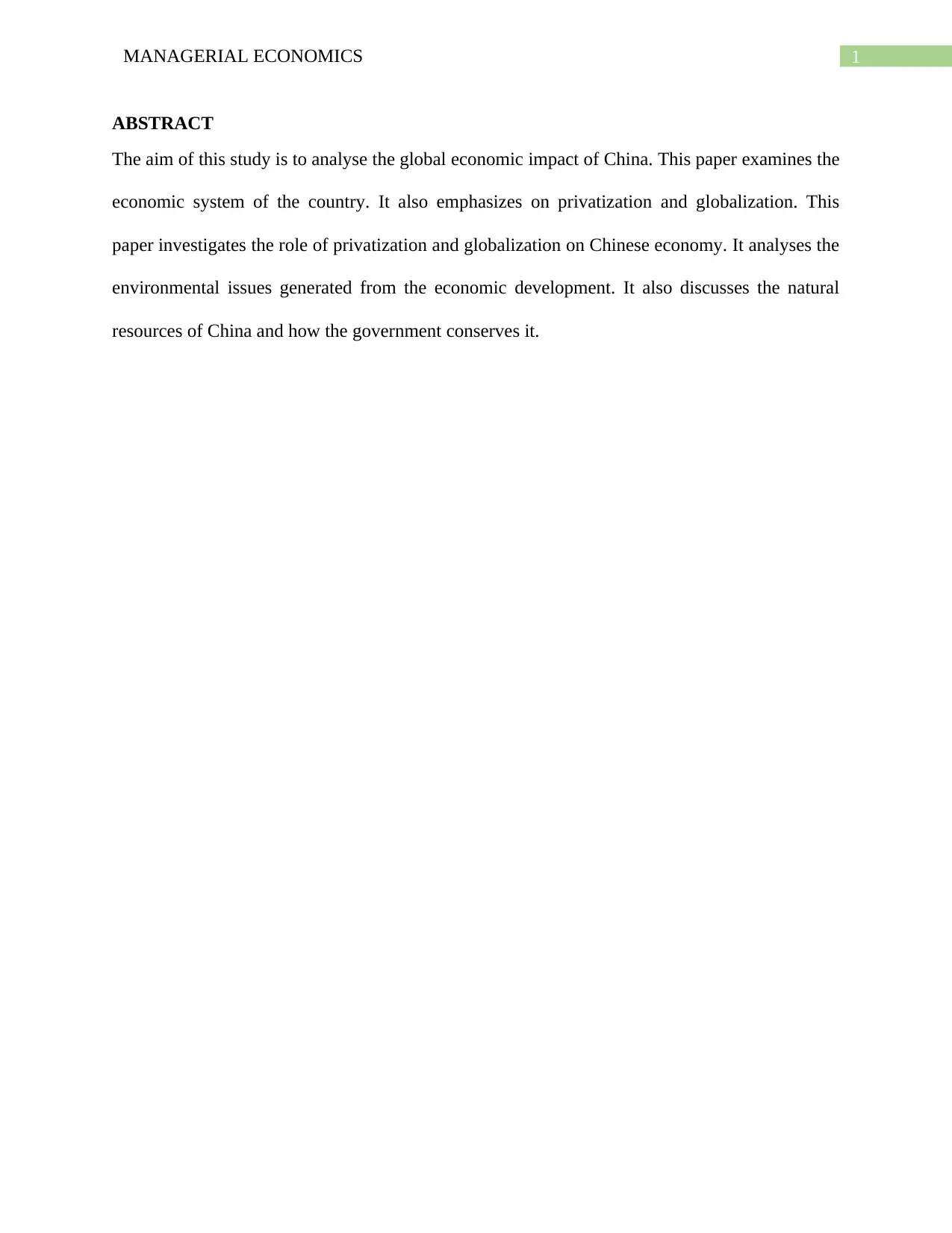
1MANAGERIAL ECONOMICS
ABSTRACT
The aim of this study is to analyse the global economic impact of China. This paper examines the
economic system of the country. It also emphasizes on privatization and globalization. This
paper investigates the role of privatization and globalization on Chinese economy. It analyses the
environmental issues generated from the economic development. It also discusses the natural
resources of China and how the government conserves it.
ABSTRACT
The aim of this study is to analyse the global economic impact of China. This paper examines the
economic system of the country. It also emphasizes on privatization and globalization. This
paper investigates the role of privatization and globalization on Chinese economy. It analyses the
environmental issues generated from the economic development. It also discusses the natural
resources of China and how the government conserves it.
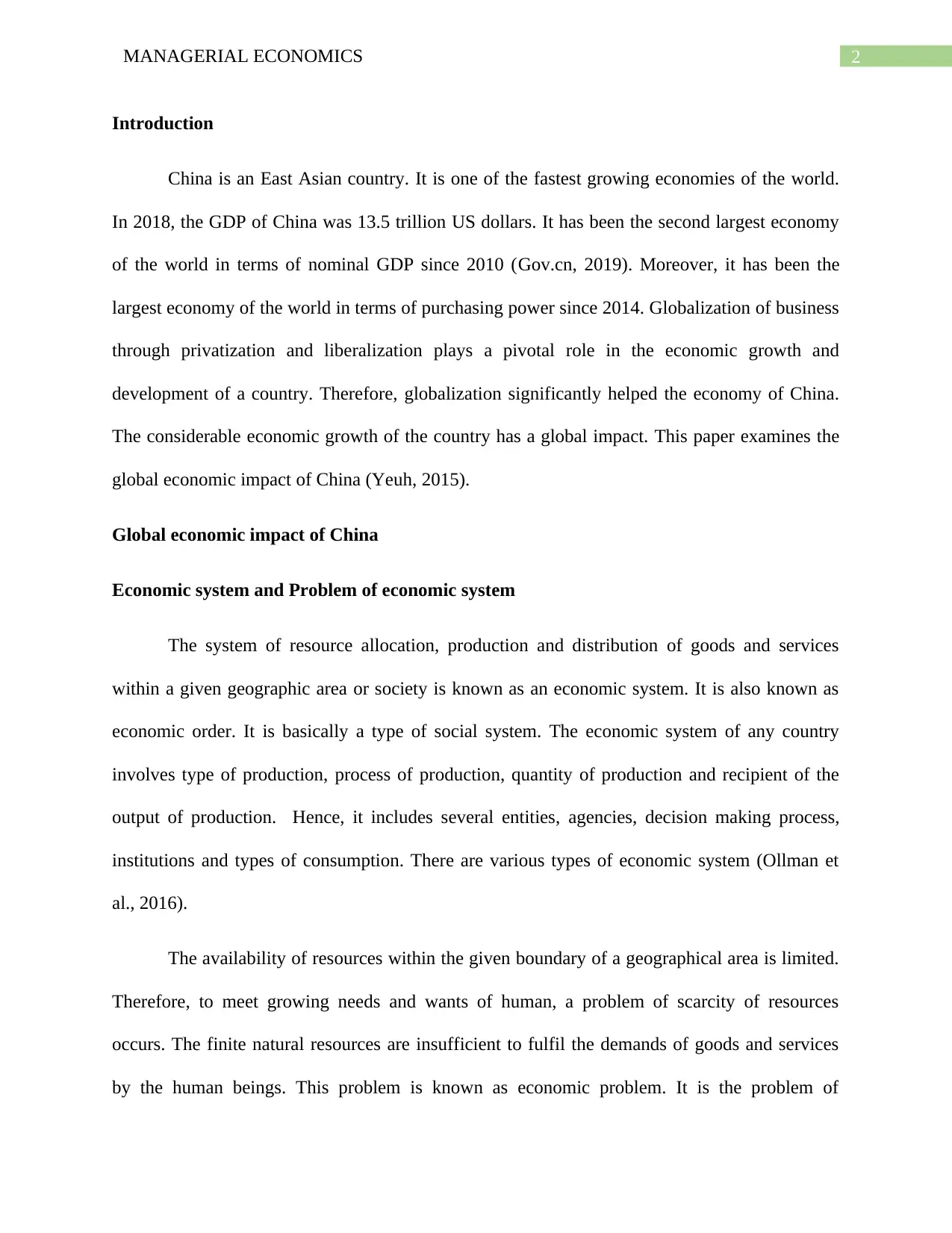
2MANAGERIAL ECONOMICS
Introduction
China is an East Asian country. It is one of the fastest growing economies of the world.
In 2018, the GDP of China was 13.5 trillion US dollars. It has been the second largest economy
of the world in terms of nominal GDP since 2010 (Gov.cn, 2019). Moreover, it has been the
largest economy of the world in terms of purchasing power since 2014. Globalization of business
through privatization and liberalization plays a pivotal role in the economic growth and
development of a country. Therefore, globalization significantly helped the economy of China.
The considerable economic growth of the country has a global impact. This paper examines the
global economic impact of China (Yeuh, 2015).
Global economic impact of China
Economic system and Problem of economic system
The system of resource allocation, production and distribution of goods and services
within a given geographic area or society is known as an economic system. It is also known as
economic order. It is basically a type of social system. The economic system of any country
involves type of production, process of production, quantity of production and recipient of the
output of production. Hence, it includes several entities, agencies, decision making process,
institutions and types of consumption. There are various types of economic system (Ollman et
al., 2016).
The availability of resources within the given boundary of a geographical area is limited.
Therefore, to meet growing needs and wants of human, a problem of scarcity of resources
occurs. The finite natural resources are insufficient to fulfil the demands of goods and services
by the human beings. This problem is known as economic problem. It is the problem of
Introduction
China is an East Asian country. It is one of the fastest growing economies of the world.
In 2018, the GDP of China was 13.5 trillion US dollars. It has been the second largest economy
of the world in terms of nominal GDP since 2010 (Gov.cn, 2019). Moreover, it has been the
largest economy of the world in terms of purchasing power since 2014. Globalization of business
through privatization and liberalization plays a pivotal role in the economic growth and
development of a country. Therefore, globalization significantly helped the economy of China.
The considerable economic growth of the country has a global impact. This paper examines the
global economic impact of China (Yeuh, 2015).
Global economic impact of China
Economic system and Problem of economic system
The system of resource allocation, production and distribution of goods and services
within a given geographic area or society is known as an economic system. It is also known as
economic order. It is basically a type of social system. The economic system of any country
involves type of production, process of production, quantity of production and recipient of the
output of production. Hence, it includes several entities, agencies, decision making process,
institutions and types of consumption. There are various types of economic system (Ollman et
al., 2016).
The availability of resources within the given boundary of a geographical area is limited.
Therefore, to meet growing needs and wants of human, a problem of scarcity of resources
occurs. The finite natural resources are insufficient to fulfil the demands of goods and services
by the human beings. This problem is known as economic problem. It is the problem of
⊘ This is a preview!⊘
Do you want full access?
Subscribe today to unlock all pages.

Trusted by 1+ million students worldwide
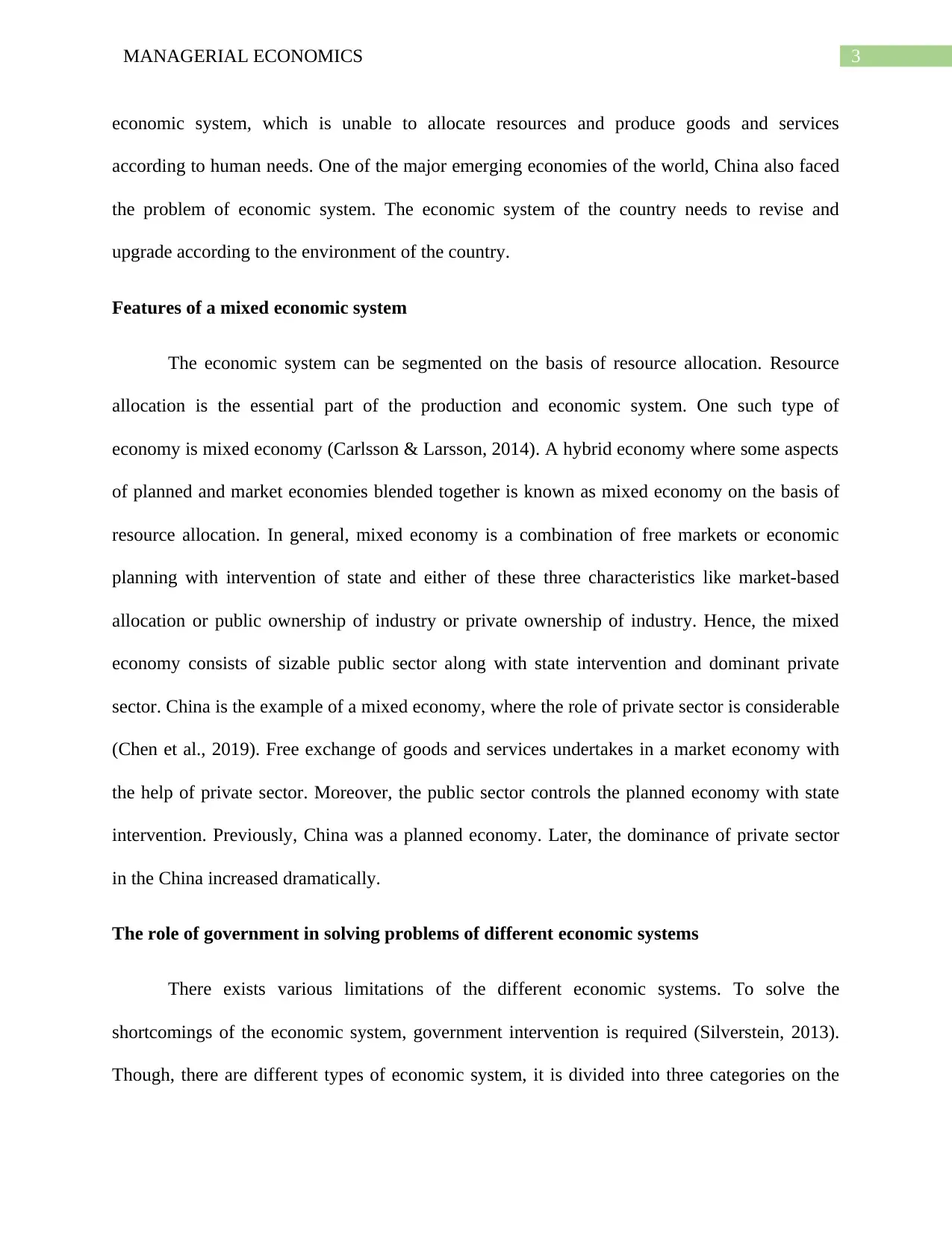
3MANAGERIAL ECONOMICS
economic system, which is unable to allocate resources and produce goods and services
according to human needs. One of the major emerging economies of the world, China also faced
the problem of economic system. The economic system of the country needs to revise and
upgrade according to the environment of the country.
Features of a mixed economic system
The economic system can be segmented on the basis of resource allocation. Resource
allocation is the essential part of the production and economic system. One such type of
economy is mixed economy (Carlsson & Larsson, 2014). A hybrid economy where some aspects
of planned and market economies blended together is known as mixed economy on the basis of
resource allocation. In general, mixed economy is a combination of free markets or economic
planning with intervention of state and either of these three characteristics like market-based
allocation or public ownership of industry or private ownership of industry. Hence, the mixed
economy consists of sizable public sector along with state intervention and dominant private
sector. China is the example of a mixed economy, where the role of private sector is considerable
(Chen et al., 2019). Free exchange of goods and services undertakes in a market economy with
the help of private sector. Moreover, the public sector controls the planned economy with state
intervention. Previously, China was a planned economy. Later, the dominance of private sector
in the China increased dramatically.
The role of government in solving problems of different economic systems
There exists various limitations of the different economic systems. To solve the
shortcomings of the economic system, government intervention is required (Silverstein, 2013).
Though, there are different types of economic system, it is divided into three categories on the
economic system, which is unable to allocate resources and produce goods and services
according to human needs. One of the major emerging economies of the world, China also faced
the problem of economic system. The economic system of the country needs to revise and
upgrade according to the environment of the country.
Features of a mixed economic system
The economic system can be segmented on the basis of resource allocation. Resource
allocation is the essential part of the production and economic system. One such type of
economy is mixed economy (Carlsson & Larsson, 2014). A hybrid economy where some aspects
of planned and market economies blended together is known as mixed economy on the basis of
resource allocation. In general, mixed economy is a combination of free markets or economic
planning with intervention of state and either of these three characteristics like market-based
allocation or public ownership of industry or private ownership of industry. Hence, the mixed
economy consists of sizable public sector along with state intervention and dominant private
sector. China is the example of a mixed economy, where the role of private sector is considerable
(Chen et al., 2019). Free exchange of goods and services undertakes in a market economy with
the help of private sector. Moreover, the public sector controls the planned economy with state
intervention. Previously, China was a planned economy. Later, the dominance of private sector
in the China increased dramatically.
The role of government in solving problems of different economic systems
There exists various limitations of the different economic systems. To solve the
shortcomings of the economic system, government intervention is required (Silverstein, 2013).
Though, there are different types of economic system, it is divided into three categories on the
Paraphrase This Document
Need a fresh take? Get an instant paraphrase of this document with our AI Paraphraser
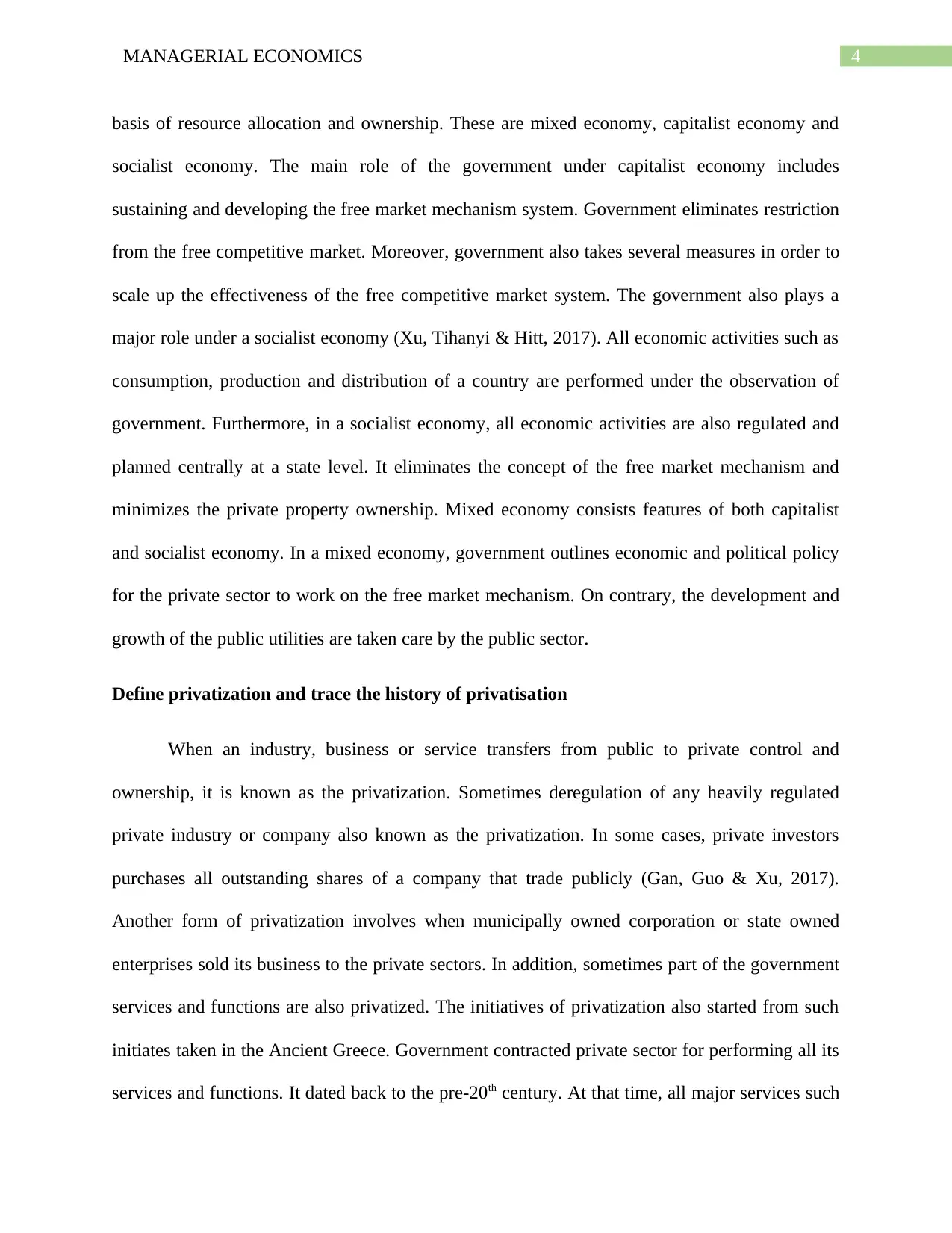
4MANAGERIAL ECONOMICS
basis of resource allocation and ownership. These are mixed economy, capitalist economy and
socialist economy. The main role of the government under capitalist economy includes
sustaining and developing the free market mechanism system. Government eliminates restriction
from the free competitive market. Moreover, government also takes several measures in order to
scale up the effectiveness of the free competitive market system. The government also plays a
major role under a socialist economy (Xu, Tihanyi & Hitt, 2017). All economic activities such as
consumption, production and distribution of a country are performed under the observation of
government. Furthermore, in a socialist economy, all economic activities are also regulated and
planned centrally at a state level. It eliminates the concept of the free market mechanism and
minimizes the private property ownership. Mixed economy consists features of both capitalist
and socialist economy. In a mixed economy, government outlines economic and political policy
for the private sector to work on the free market mechanism. On contrary, the development and
growth of the public utilities are taken care by the public sector.
Define privatization and trace the history of privatisation
When an industry, business or service transfers from public to private control and
ownership, it is known as the privatization. Sometimes deregulation of any heavily regulated
private industry or company also known as the privatization. In some cases, private investors
purchases all outstanding shares of a company that trade publicly (Gan, Guo & Xu, 2017).
Another form of privatization involves when municipally owned corporation or state owned
enterprises sold its business to the private sectors. In addition, sometimes part of the government
services and functions are also privatized. The initiatives of privatization also started from such
initiates taken in the Ancient Greece. Government contracted private sector for performing all its
services and functions. It dated back to the pre-20th century. At that time, all major services such
basis of resource allocation and ownership. These are mixed economy, capitalist economy and
socialist economy. The main role of the government under capitalist economy includes
sustaining and developing the free market mechanism system. Government eliminates restriction
from the free competitive market. Moreover, government also takes several measures in order to
scale up the effectiveness of the free competitive market system. The government also plays a
major role under a socialist economy (Xu, Tihanyi & Hitt, 2017). All economic activities such as
consumption, production and distribution of a country are performed under the observation of
government. Furthermore, in a socialist economy, all economic activities are also regulated and
planned centrally at a state level. It eliminates the concept of the free market mechanism and
minimizes the private property ownership. Mixed economy consists features of both capitalist
and socialist economy. In a mixed economy, government outlines economic and political policy
for the private sector to work on the free market mechanism. On contrary, the development and
growth of the public utilities are taken care by the public sector.
Define privatization and trace the history of privatisation
When an industry, business or service transfers from public to private control and
ownership, it is known as the privatization. Sometimes deregulation of any heavily regulated
private industry or company also known as the privatization. In some cases, private investors
purchases all outstanding shares of a company that trade publicly (Gan, Guo & Xu, 2017).
Another form of privatization involves when municipally owned corporation or state owned
enterprises sold its business to the private sectors. In addition, sometimes part of the government
services and functions are also privatized. The initiatives of privatization also started from such
initiates taken in the Ancient Greece. Government contracted private sector for performing all its
services and functions. It dated back to the pre-20th century. At that time, all major services such
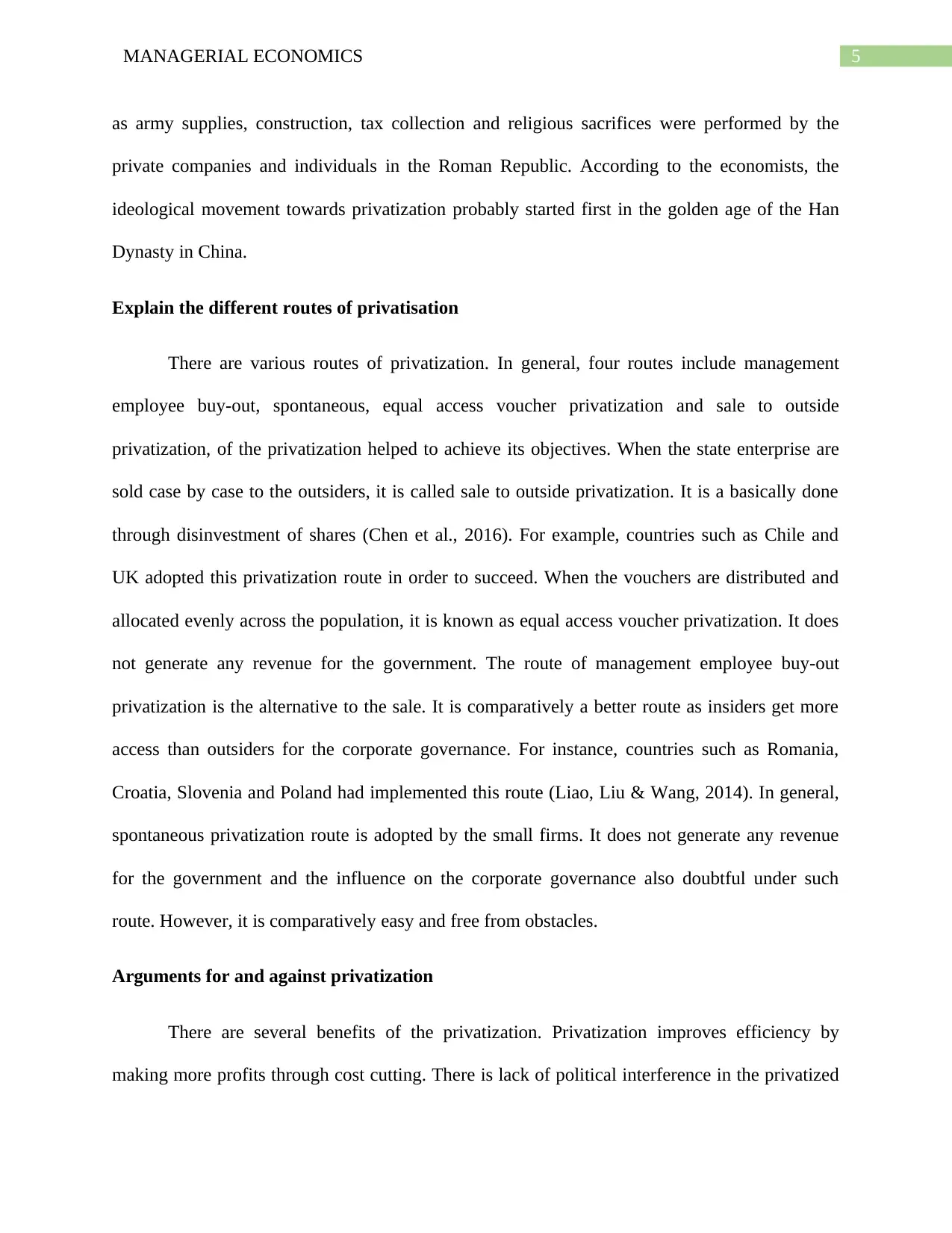
5MANAGERIAL ECONOMICS
as army supplies, construction, tax collection and religious sacrifices were performed by the
private companies and individuals in the Roman Republic. According to the economists, the
ideological movement towards privatization probably started first in the golden age of the Han
Dynasty in China.
Explain the different routes of privatisation
There are various routes of privatization. In general, four routes include management
employee buy-out, spontaneous, equal access voucher privatization and sale to outside
privatization, of the privatization helped to achieve its objectives. When the state enterprise are
sold case by case to the outsiders, it is called sale to outside privatization. It is a basically done
through disinvestment of shares (Chen et al., 2016). For example, countries such as Chile and
UK adopted this privatization route in order to succeed. When the vouchers are distributed and
allocated evenly across the population, it is known as equal access voucher privatization. It does
not generate any revenue for the government. The route of management employee buy-out
privatization is the alternative to the sale. It is comparatively a better route as insiders get more
access than outsiders for the corporate governance. For instance, countries such as Romania,
Croatia, Slovenia and Poland had implemented this route (Liao, Liu & Wang, 2014). In general,
spontaneous privatization route is adopted by the small firms. It does not generate any revenue
for the government and the influence on the corporate governance also doubtful under such
route. However, it is comparatively easy and free from obstacles.
Arguments for and against privatization
There are several benefits of the privatization. Privatization improves efficiency by
making more profits through cost cutting. There is lack of political interference in the privatized
as army supplies, construction, tax collection and religious sacrifices were performed by the
private companies and individuals in the Roman Republic. According to the economists, the
ideological movement towards privatization probably started first in the golden age of the Han
Dynasty in China.
Explain the different routes of privatisation
There are various routes of privatization. In general, four routes include management
employee buy-out, spontaneous, equal access voucher privatization and sale to outside
privatization, of the privatization helped to achieve its objectives. When the state enterprise are
sold case by case to the outsiders, it is called sale to outside privatization. It is a basically done
through disinvestment of shares (Chen et al., 2016). For example, countries such as Chile and
UK adopted this privatization route in order to succeed. When the vouchers are distributed and
allocated evenly across the population, it is known as equal access voucher privatization. It does
not generate any revenue for the government. The route of management employee buy-out
privatization is the alternative to the sale. It is comparatively a better route as insiders get more
access than outsiders for the corporate governance. For instance, countries such as Romania,
Croatia, Slovenia and Poland had implemented this route (Liao, Liu & Wang, 2014). In general,
spontaneous privatization route is adopted by the small firms. It does not generate any revenue
for the government and the influence on the corporate governance also doubtful under such
route. However, it is comparatively easy and free from obstacles.
Arguments for and against privatization
There are several benefits of the privatization. Privatization improves efficiency by
making more profits through cost cutting. There is lack of political interference in the privatized
⊘ This is a preview!⊘
Do you want full access?
Subscribe today to unlock all pages.

Trusted by 1+ million students worldwide
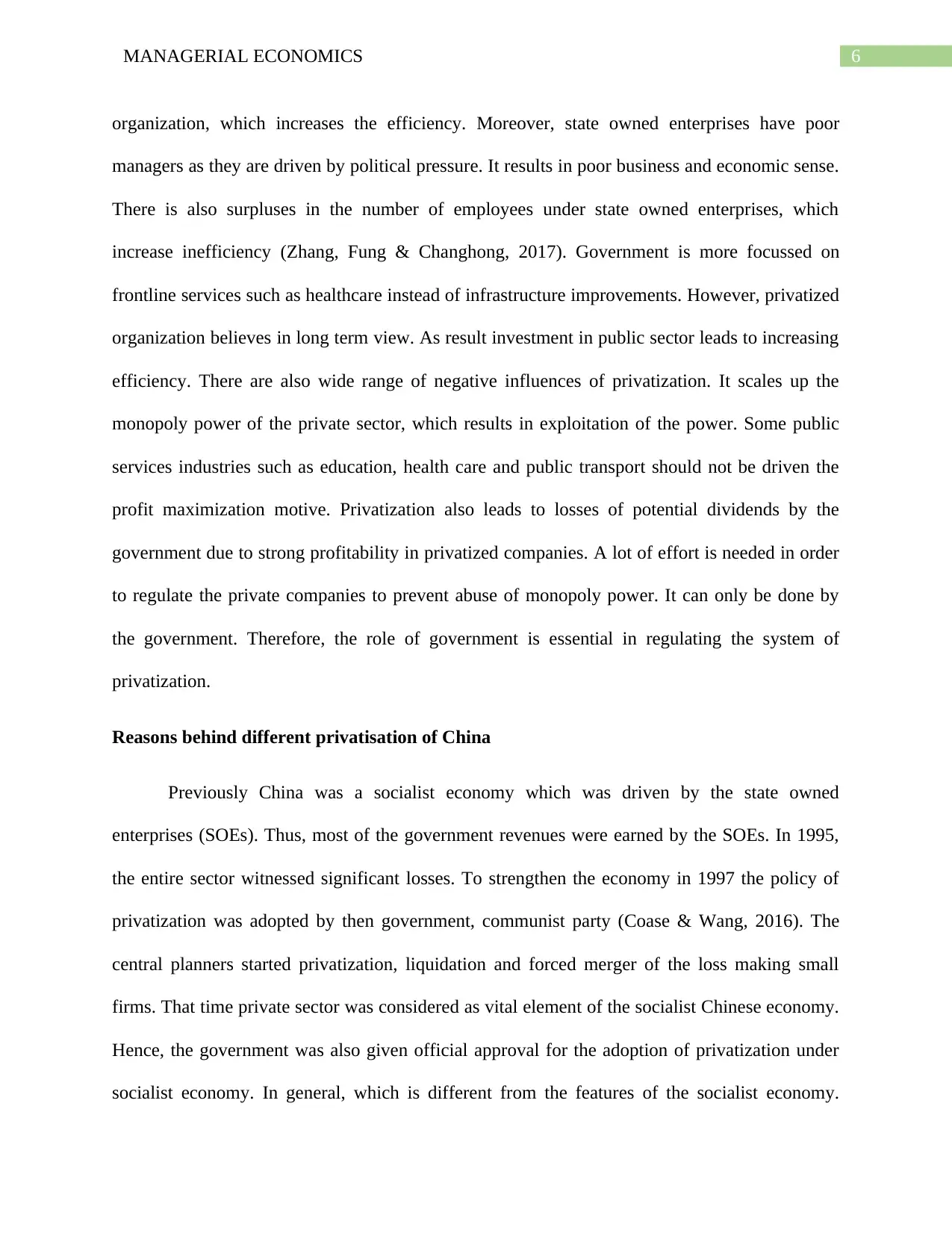
6MANAGERIAL ECONOMICS
organization, which increases the efficiency. Moreover, state owned enterprises have poor
managers as they are driven by political pressure. It results in poor business and economic sense.
There is also surpluses in the number of employees under state owned enterprises, which
increase inefficiency (Zhang, Fung & Changhong, 2017). Government is more focussed on
frontline services such as healthcare instead of infrastructure improvements. However, privatized
organization believes in long term view. As result investment in public sector leads to increasing
efficiency. There are also wide range of negative influences of privatization. It scales up the
monopoly power of the private sector, which results in exploitation of the power. Some public
services industries such as education, health care and public transport should not be driven the
profit maximization motive. Privatization also leads to losses of potential dividends by the
government due to strong profitability in privatized companies. A lot of effort is needed in order
to regulate the private companies to prevent abuse of monopoly power. It can only be done by
the government. Therefore, the role of government is essential in regulating the system of
privatization.
Reasons behind different privatisation of China
Previously China was a socialist economy which was driven by the state owned
enterprises (SOEs). Thus, most of the government revenues were earned by the SOEs. In 1995,
the entire sector witnessed significant losses. To strengthen the economy in 1997 the policy of
privatization was adopted by then government, communist party (Coase & Wang, 2016). The
central planners started privatization, liquidation and forced merger of the loss making small
firms. That time private sector was considered as vital element of the socialist Chinese economy.
Hence, the government was also given official approval for the adoption of privatization under
socialist economy. In general, which is different from the features of the socialist economy.
organization, which increases the efficiency. Moreover, state owned enterprises have poor
managers as they are driven by political pressure. It results in poor business and economic sense.
There is also surpluses in the number of employees under state owned enterprises, which
increase inefficiency (Zhang, Fung & Changhong, 2017). Government is more focussed on
frontline services such as healthcare instead of infrastructure improvements. However, privatized
organization believes in long term view. As result investment in public sector leads to increasing
efficiency. There are also wide range of negative influences of privatization. It scales up the
monopoly power of the private sector, which results in exploitation of the power. Some public
services industries such as education, health care and public transport should not be driven the
profit maximization motive. Privatization also leads to losses of potential dividends by the
government due to strong profitability in privatized companies. A lot of effort is needed in order
to regulate the private companies to prevent abuse of monopoly power. It can only be done by
the government. Therefore, the role of government is essential in regulating the system of
privatization.
Reasons behind different privatisation of China
Previously China was a socialist economy which was driven by the state owned
enterprises (SOEs). Thus, most of the government revenues were earned by the SOEs. In 1995,
the entire sector witnessed significant losses. To strengthen the economy in 1997 the policy of
privatization was adopted by then government, communist party (Coase & Wang, 2016). The
central planners started privatization, liquidation and forced merger of the loss making small
firms. That time private sector was considered as vital element of the socialist Chinese economy.
Hence, the government was also given official approval for the adoption of privatization under
socialist economy. In general, which is different from the features of the socialist economy.
Paraphrase This Document
Need a fresh take? Get an instant paraphrase of this document with our AI Paraphraser
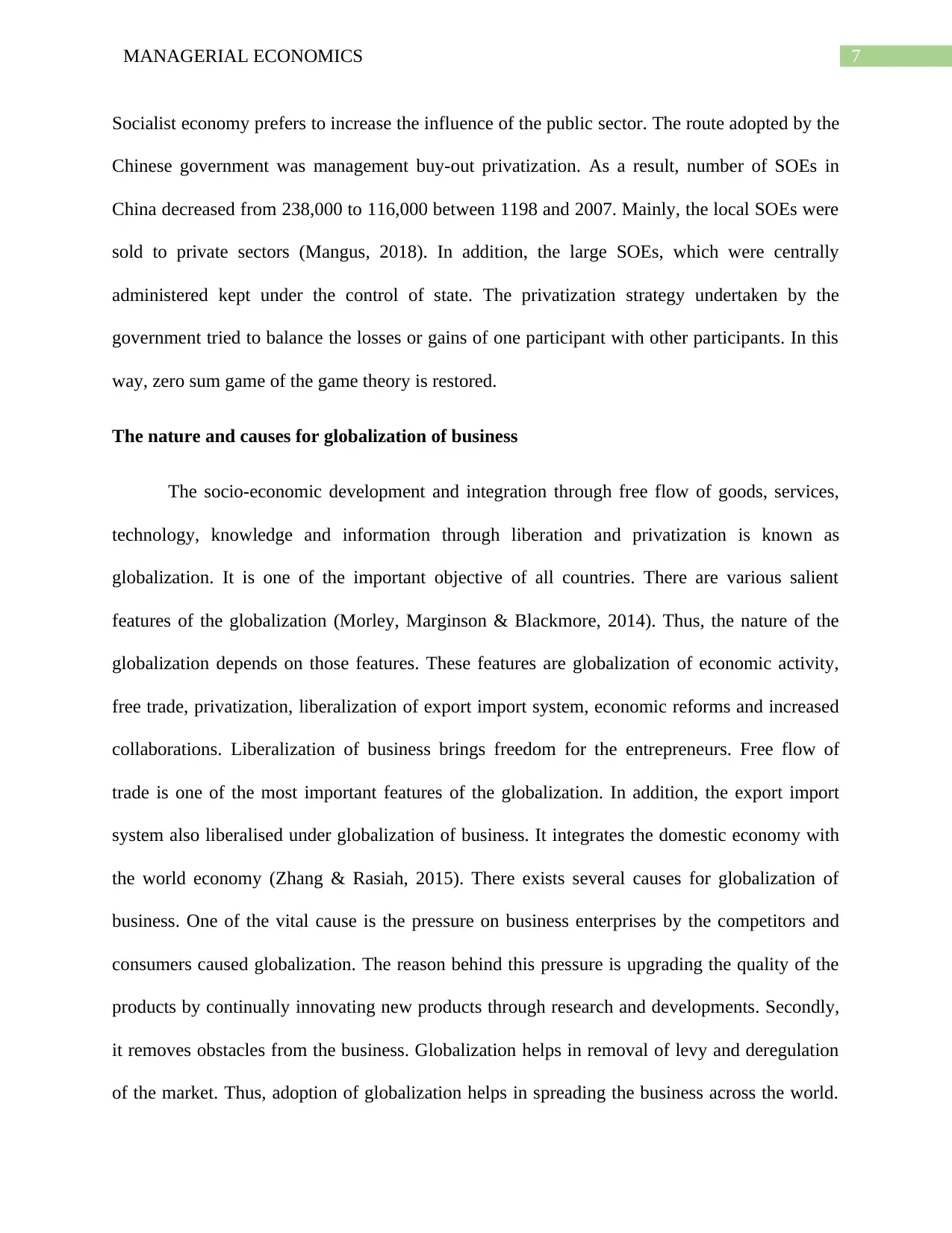
7MANAGERIAL ECONOMICS
Socialist economy prefers to increase the influence of the public sector. The route adopted by the
Chinese government was management buy-out privatization. As a result, number of SOEs in
China decreased from 238,000 to 116,000 between 1198 and 2007. Mainly, the local SOEs were
sold to private sectors (Mangus, 2018). In addition, the large SOEs, which were centrally
administered kept under the control of state. The privatization strategy undertaken by the
government tried to balance the losses or gains of one participant with other participants. In this
way, zero sum game of the game theory is restored.
The nature and causes for globalization of business
The socio-economic development and integration through free flow of goods, services,
technology, knowledge and information through liberation and privatization is known as
globalization. It is one of the important objective of all countries. There are various salient
features of the globalization (Morley, Marginson & Blackmore, 2014). Thus, the nature of the
globalization depends on those features. These features are globalization of economic activity,
free trade, privatization, liberalization of export import system, economic reforms and increased
collaborations. Liberalization of business brings freedom for the entrepreneurs. Free flow of
trade is one of the most important features of the globalization. In addition, the export import
system also liberalised under globalization of business. It integrates the domestic economy with
the world economy (Zhang & Rasiah, 2015). There exists several causes for globalization of
business. One of the vital cause is the pressure on business enterprises by the competitors and
consumers caused globalization. The reason behind this pressure is upgrading the quality of the
products by continually innovating new products through research and developments. Secondly,
it removes obstacles from the business. Globalization helps in removal of levy and deregulation
of the market. Thus, adoption of globalization helps in spreading the business across the world.
Socialist economy prefers to increase the influence of the public sector. The route adopted by the
Chinese government was management buy-out privatization. As a result, number of SOEs in
China decreased from 238,000 to 116,000 between 1198 and 2007. Mainly, the local SOEs were
sold to private sectors (Mangus, 2018). In addition, the large SOEs, which were centrally
administered kept under the control of state. The privatization strategy undertaken by the
government tried to balance the losses or gains of one participant with other participants. In this
way, zero sum game of the game theory is restored.
The nature and causes for globalization of business
The socio-economic development and integration through free flow of goods, services,
technology, knowledge and information through liberation and privatization is known as
globalization. It is one of the important objective of all countries. There are various salient
features of the globalization (Morley, Marginson & Blackmore, 2014). Thus, the nature of the
globalization depends on those features. These features are globalization of economic activity,
free trade, privatization, liberalization of export import system, economic reforms and increased
collaborations. Liberalization of business brings freedom for the entrepreneurs. Free flow of
trade is one of the most important features of the globalization. In addition, the export import
system also liberalised under globalization of business. It integrates the domestic economy with
the world economy (Zhang & Rasiah, 2015). There exists several causes for globalization of
business. One of the vital cause is the pressure on business enterprises by the competitors and
consumers caused globalization. The reason behind this pressure is upgrading the quality of the
products by continually innovating new products through research and developments. Secondly,
it removes obstacles from the business. Globalization helps in removal of levy and deregulation
of the market. Thus, adoption of globalization helps in spreading the business across the world.
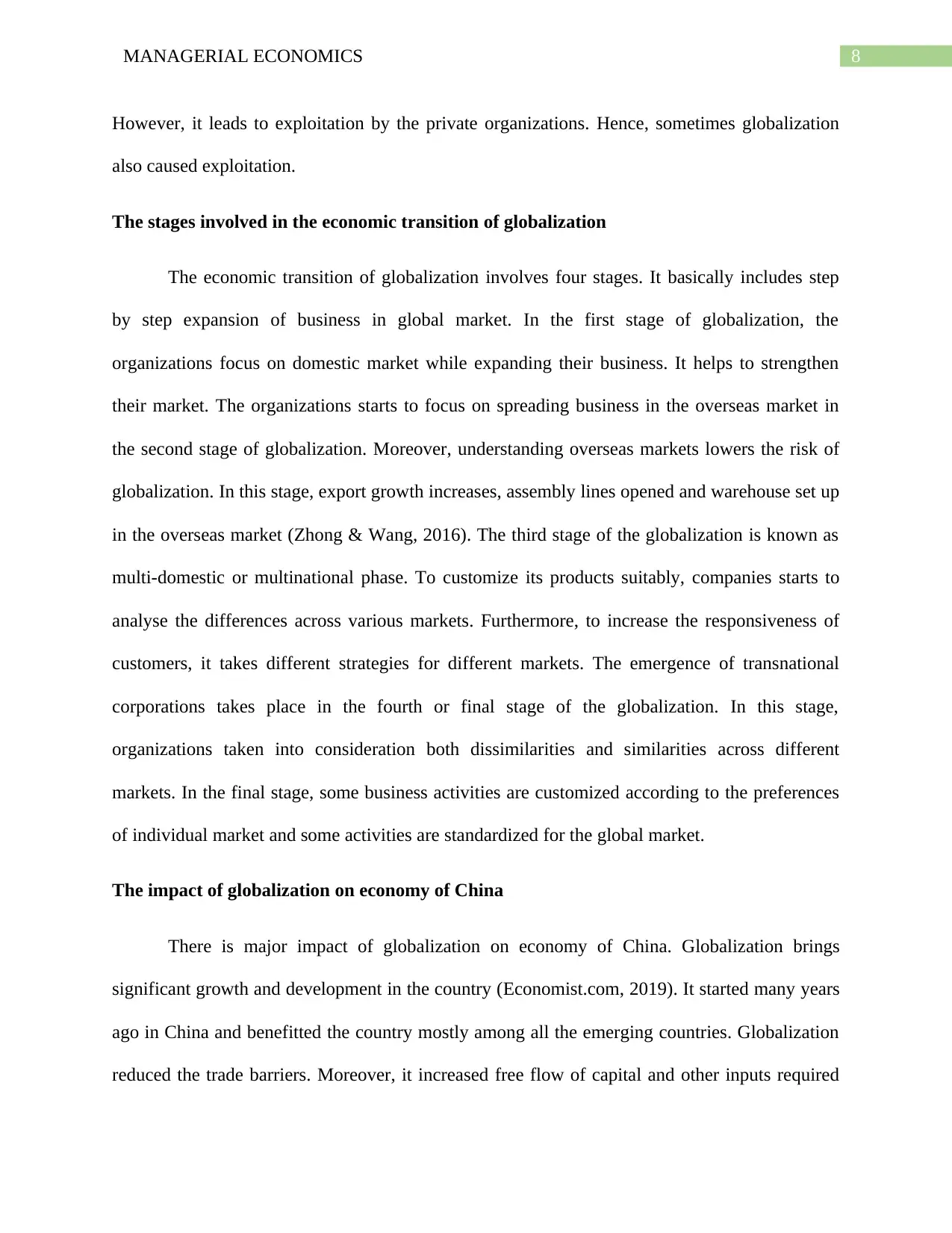
8MANAGERIAL ECONOMICS
However, it leads to exploitation by the private organizations. Hence, sometimes globalization
also caused exploitation.
The stages involved in the economic transition of globalization
The economic transition of globalization involves four stages. It basically includes step
by step expansion of business in global market. In the first stage of globalization, the
organizations focus on domestic market while expanding their business. It helps to strengthen
their market. The organizations starts to focus on spreading business in the overseas market in
the second stage of globalization. Moreover, understanding overseas markets lowers the risk of
globalization. In this stage, export growth increases, assembly lines opened and warehouse set up
in the overseas market (Zhong & Wang, 2016). The third stage of the globalization is known as
multi-domestic or multinational phase. To customize its products suitably, companies starts to
analyse the differences across various markets. Furthermore, to increase the responsiveness of
customers, it takes different strategies for different markets. The emergence of transnational
corporations takes place in the fourth or final stage of the globalization. In this stage,
organizations taken into consideration both dissimilarities and similarities across different
markets. In the final stage, some business activities are customized according to the preferences
of individual market and some activities are standardized for the global market.
The impact of globalization on economy of China
There is major impact of globalization on economy of China. Globalization brings
significant growth and development in the country (Economist.com, 2019). It started many years
ago in China and benefitted the country mostly among all the emerging countries. Globalization
reduced the trade barriers. Moreover, it increased free flow of capital and other inputs required
However, it leads to exploitation by the private organizations. Hence, sometimes globalization
also caused exploitation.
The stages involved in the economic transition of globalization
The economic transition of globalization involves four stages. It basically includes step
by step expansion of business in global market. In the first stage of globalization, the
organizations focus on domestic market while expanding their business. It helps to strengthen
their market. The organizations starts to focus on spreading business in the overseas market in
the second stage of globalization. Moreover, understanding overseas markets lowers the risk of
globalization. In this stage, export growth increases, assembly lines opened and warehouse set up
in the overseas market (Zhong & Wang, 2016). The third stage of the globalization is known as
multi-domestic or multinational phase. To customize its products suitably, companies starts to
analyse the differences across various markets. Furthermore, to increase the responsiveness of
customers, it takes different strategies for different markets. The emergence of transnational
corporations takes place in the fourth or final stage of the globalization. In this stage,
organizations taken into consideration both dissimilarities and similarities across different
markets. In the final stage, some business activities are customized according to the preferences
of individual market and some activities are standardized for the global market.
The impact of globalization on economy of China
There is major impact of globalization on economy of China. Globalization brings
significant growth and development in the country (Economist.com, 2019). It started many years
ago in China and benefitted the country mostly among all the emerging countries. Globalization
reduced the trade barriers. Moreover, it increased free flow of capital and other inputs required
⊘ This is a preview!⊘
Do you want full access?
Subscribe today to unlock all pages.

Trusted by 1+ million students worldwide
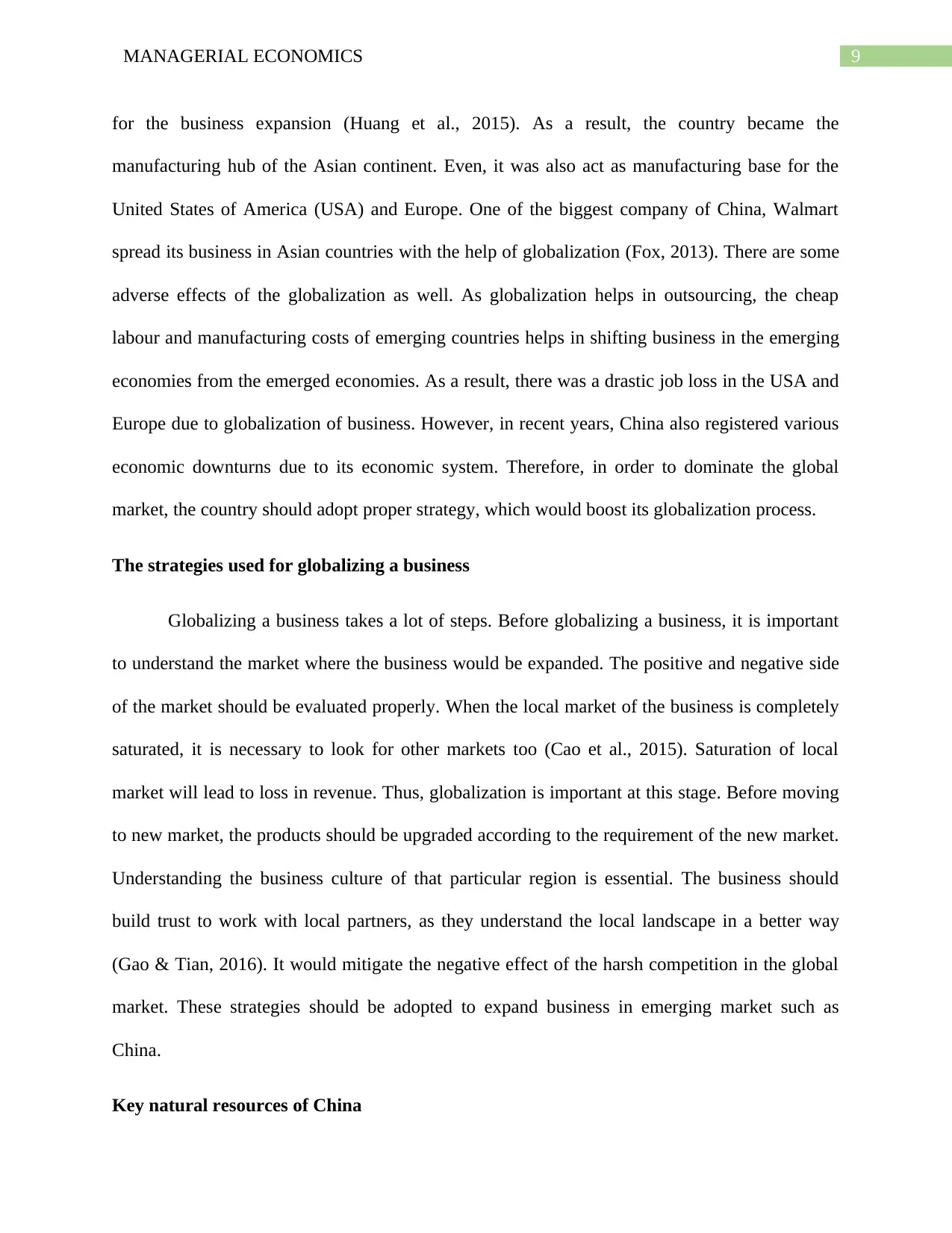
9MANAGERIAL ECONOMICS
for the business expansion (Huang et al., 2015). As a result, the country became the
manufacturing hub of the Asian continent. Even, it was also act as manufacturing base for the
United States of America (USA) and Europe. One of the biggest company of China, Walmart
spread its business in Asian countries with the help of globalization (Fox, 2013). There are some
adverse effects of the globalization as well. As globalization helps in outsourcing, the cheap
labour and manufacturing costs of emerging countries helps in shifting business in the emerging
economies from the emerged economies. As a result, there was a drastic job loss in the USA and
Europe due to globalization of business. However, in recent years, China also registered various
economic downturns due to its economic system. Therefore, in order to dominate the global
market, the country should adopt proper strategy, which would boost its globalization process.
The strategies used for globalizing a business
Globalizing a business takes a lot of steps. Before globalizing a business, it is important
to understand the market where the business would be expanded. The positive and negative side
of the market should be evaluated properly. When the local market of the business is completely
saturated, it is necessary to look for other markets too (Cao et al., 2015). Saturation of local
market will lead to loss in revenue. Thus, globalization is important at this stage. Before moving
to new market, the products should be upgraded according to the requirement of the new market.
Understanding the business culture of that particular region is essential. The business should
build trust to work with local partners, as they understand the local landscape in a better way
(Gao & Tian, 2016). It would mitigate the negative effect of the harsh competition in the global
market. These strategies should be adopted to expand business in emerging market such as
China.
Key natural resources of China
for the business expansion (Huang et al., 2015). As a result, the country became the
manufacturing hub of the Asian continent. Even, it was also act as manufacturing base for the
United States of America (USA) and Europe. One of the biggest company of China, Walmart
spread its business in Asian countries with the help of globalization (Fox, 2013). There are some
adverse effects of the globalization as well. As globalization helps in outsourcing, the cheap
labour and manufacturing costs of emerging countries helps in shifting business in the emerging
economies from the emerged economies. As a result, there was a drastic job loss in the USA and
Europe due to globalization of business. However, in recent years, China also registered various
economic downturns due to its economic system. Therefore, in order to dominate the global
market, the country should adopt proper strategy, which would boost its globalization process.
The strategies used for globalizing a business
Globalizing a business takes a lot of steps. Before globalizing a business, it is important
to understand the market where the business would be expanded. The positive and negative side
of the market should be evaluated properly. When the local market of the business is completely
saturated, it is necessary to look for other markets too (Cao et al., 2015). Saturation of local
market will lead to loss in revenue. Thus, globalization is important at this stage. Before moving
to new market, the products should be upgraded according to the requirement of the new market.
Understanding the business culture of that particular region is essential. The business should
build trust to work with local partners, as they understand the local landscape in a better way
(Gao & Tian, 2016). It would mitigate the negative effect of the harsh competition in the global
market. These strategies should be adopted to expand business in emerging market such as
China.
Key natural resources of China
Paraphrase This Document
Need a fresh take? Get an instant paraphrase of this document with our AI Paraphraser
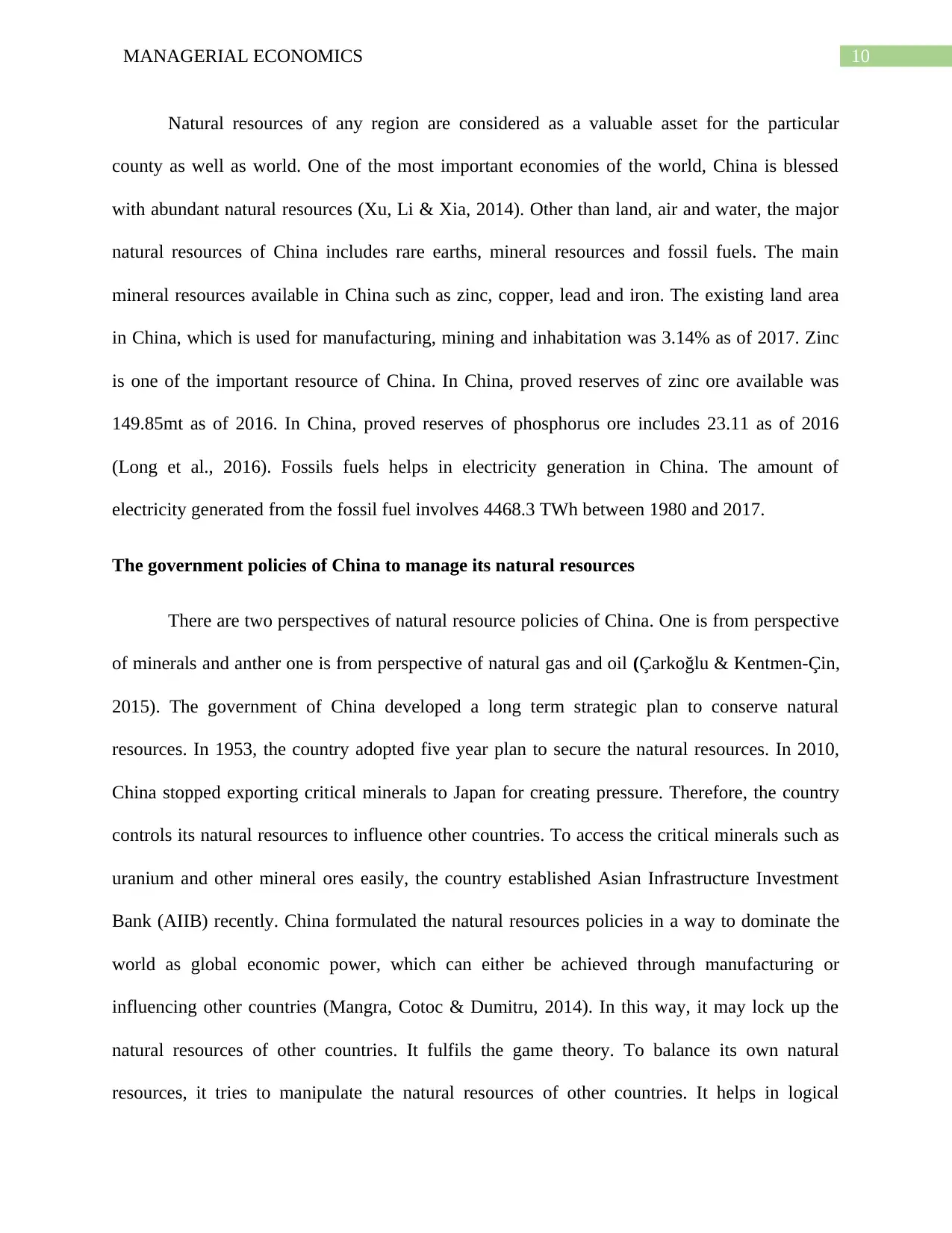
10MANAGERIAL ECONOMICS
Natural resources of any region are considered as a valuable asset for the particular
county as well as world. One of the most important economies of the world, China is blessed
with abundant natural resources (Xu, Li & Xia, 2014). Other than land, air and water, the major
natural resources of China includes rare earths, mineral resources and fossil fuels. The main
mineral resources available in China such as zinc, copper, lead and iron. The existing land area
in China, which is used for manufacturing, mining and inhabitation was 3.14% as of 2017. Zinc
is one of the important resource of China. In China, proved reserves of zinc ore available was
149.85mt as of 2016. In China, proved reserves of phosphorus ore includes 23.11 as of 2016
(Long et al., 2016). Fossils fuels helps in electricity generation in China. The amount of
electricity generated from the fossil fuel involves 4468.3 TWh between 1980 and 2017.
The government policies of China to manage its natural resources
There are two perspectives of natural resource policies of China. One is from perspective
of minerals and anther one is from perspective of natural gas and oil (Çarkoğlu & Kentmen-Çin,
2015). The government of China developed a long term strategic plan to conserve natural
resources. In 1953, the country adopted five year plan to secure the natural resources. In 2010,
China stopped exporting critical minerals to Japan for creating pressure. Therefore, the country
controls its natural resources to influence other countries. To access the critical minerals such as
uranium and other mineral ores easily, the country established Asian Infrastructure Investment
Bank (AIIB) recently. China formulated the natural resources policies in a way to dominate the
world as global economic power, which can either be achieved through manufacturing or
influencing other countries (Mangra, Cotoc & Dumitru, 2014). In this way, it may lock up the
natural resources of other countries. It fulfils the game theory. To balance its own natural
resources, it tries to manipulate the natural resources of other countries. It helps in logical
Natural resources of any region are considered as a valuable asset for the particular
county as well as world. One of the most important economies of the world, China is blessed
with abundant natural resources (Xu, Li & Xia, 2014). Other than land, air and water, the major
natural resources of China includes rare earths, mineral resources and fossil fuels. The main
mineral resources available in China such as zinc, copper, lead and iron. The existing land area
in China, which is used for manufacturing, mining and inhabitation was 3.14% as of 2017. Zinc
is one of the important resource of China. In China, proved reserves of zinc ore available was
149.85mt as of 2016. In China, proved reserves of phosphorus ore includes 23.11 as of 2016
(Long et al., 2016). Fossils fuels helps in electricity generation in China. The amount of
electricity generated from the fossil fuel involves 4468.3 TWh between 1980 and 2017.
The government policies of China to manage its natural resources
There are two perspectives of natural resource policies of China. One is from perspective
of minerals and anther one is from perspective of natural gas and oil (Çarkoğlu & Kentmen-Çin,
2015). The government of China developed a long term strategic plan to conserve natural
resources. In 1953, the country adopted five year plan to secure the natural resources. In 2010,
China stopped exporting critical minerals to Japan for creating pressure. Therefore, the country
controls its natural resources to influence other countries. To access the critical minerals such as
uranium and other mineral ores easily, the country established Asian Infrastructure Investment
Bank (AIIB) recently. China formulated the natural resources policies in a way to dominate the
world as global economic power, which can either be achieved through manufacturing or
influencing other countries (Mangra, Cotoc & Dumitru, 2014). In this way, it may lock up the
natural resources of other countries. It fulfils the game theory. To balance its own natural
resources, it tries to manipulate the natural resources of other countries. It helps in logical
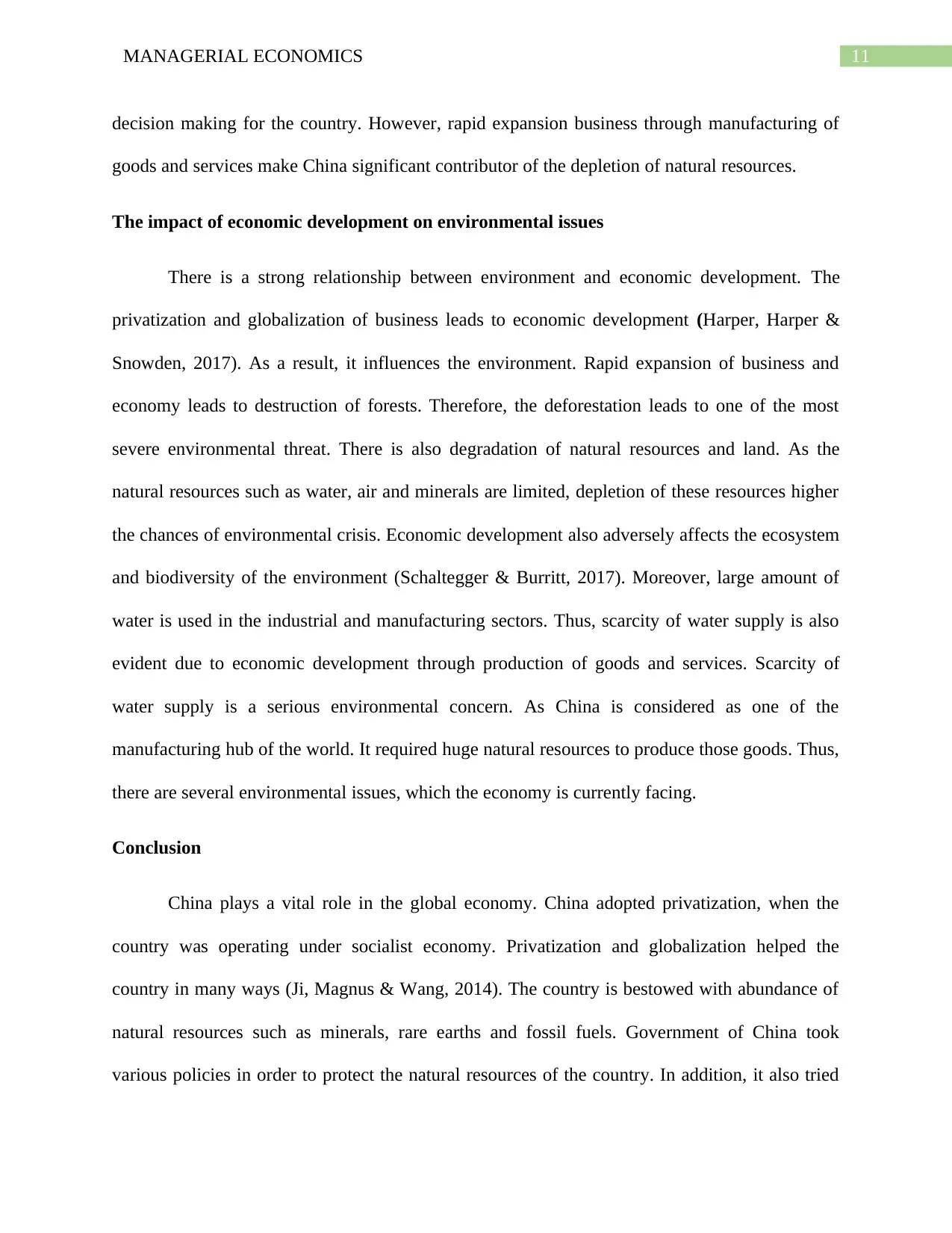
11MANAGERIAL ECONOMICS
decision making for the country. However, rapid expansion business through manufacturing of
goods and services make China significant contributor of the depletion of natural resources.
The impact of economic development on environmental issues
There is a strong relationship between environment and economic development. The
privatization and globalization of business leads to economic development (Harper, Harper &
Snowden, 2017). As a result, it influences the environment. Rapid expansion of business and
economy leads to destruction of forests. Therefore, the deforestation leads to one of the most
severe environmental threat. There is also degradation of natural resources and land. As the
natural resources such as water, air and minerals are limited, depletion of these resources higher
the chances of environmental crisis. Economic development also adversely affects the ecosystem
and biodiversity of the environment (Schaltegger & Burritt, 2017). Moreover, large amount of
water is used in the industrial and manufacturing sectors. Thus, scarcity of water supply is also
evident due to economic development through production of goods and services. Scarcity of
water supply is a serious environmental concern. As China is considered as one of the
manufacturing hub of the world. It required huge natural resources to produce those goods. Thus,
there are several environmental issues, which the economy is currently facing.
Conclusion
China plays a vital role in the global economy. China adopted privatization, when the
country was operating under socialist economy. Privatization and globalization helped the
country in many ways (Ji, Magnus & Wang, 2014). The country is bestowed with abundance of
natural resources such as minerals, rare earths and fossil fuels. Government of China took
various policies in order to protect the natural resources of the country. In addition, it also tried
decision making for the country. However, rapid expansion business through manufacturing of
goods and services make China significant contributor of the depletion of natural resources.
The impact of economic development on environmental issues
There is a strong relationship between environment and economic development. The
privatization and globalization of business leads to economic development (Harper, Harper &
Snowden, 2017). As a result, it influences the environment. Rapid expansion of business and
economy leads to destruction of forests. Therefore, the deforestation leads to one of the most
severe environmental threat. There is also degradation of natural resources and land. As the
natural resources such as water, air and minerals are limited, depletion of these resources higher
the chances of environmental crisis. Economic development also adversely affects the ecosystem
and biodiversity of the environment (Schaltegger & Burritt, 2017). Moreover, large amount of
water is used in the industrial and manufacturing sectors. Thus, scarcity of water supply is also
evident due to economic development through production of goods and services. Scarcity of
water supply is a serious environmental concern. As China is considered as one of the
manufacturing hub of the world. It required huge natural resources to produce those goods. Thus,
there are several environmental issues, which the economy is currently facing.
Conclusion
China plays a vital role in the global economy. China adopted privatization, when the
country was operating under socialist economy. Privatization and globalization helped the
country in many ways (Ji, Magnus & Wang, 2014). The country is bestowed with abundance of
natural resources such as minerals, rare earths and fossil fuels. Government of China took
various policies in order to protect the natural resources of the country. In addition, it also tried
⊘ This is a preview!⊘
Do you want full access?
Subscribe today to unlock all pages.

Trusted by 1+ million students worldwide
1 out of 16
Related Documents
Your All-in-One AI-Powered Toolkit for Academic Success.
+13062052269
info@desklib.com
Available 24*7 on WhatsApp / Email
![[object Object]](/_next/static/media/star-bottom.7253800d.svg)
Unlock your academic potential
Copyright © 2020–2025 A2Z Services. All Rights Reserved. Developed and managed by ZUCOL.





